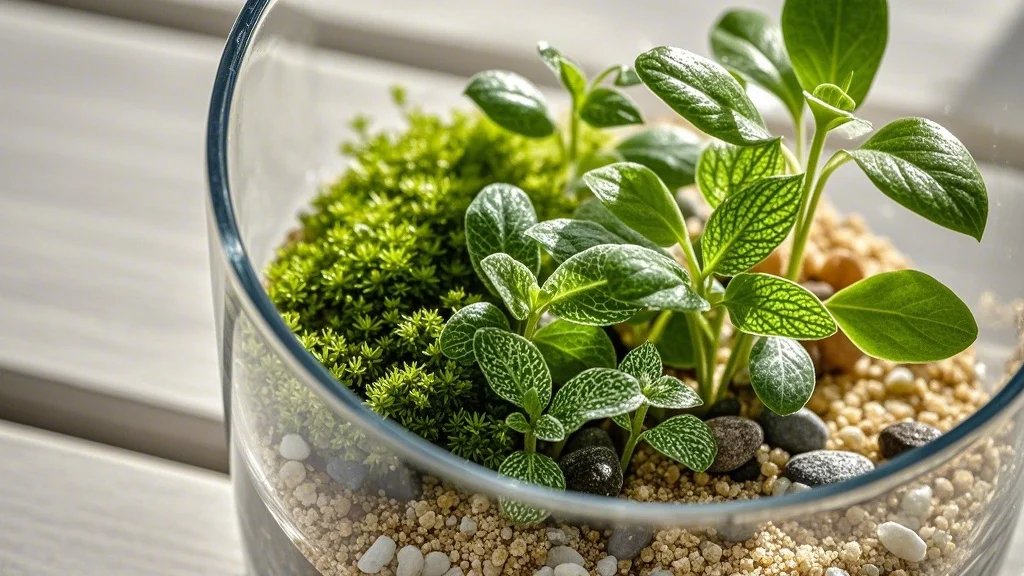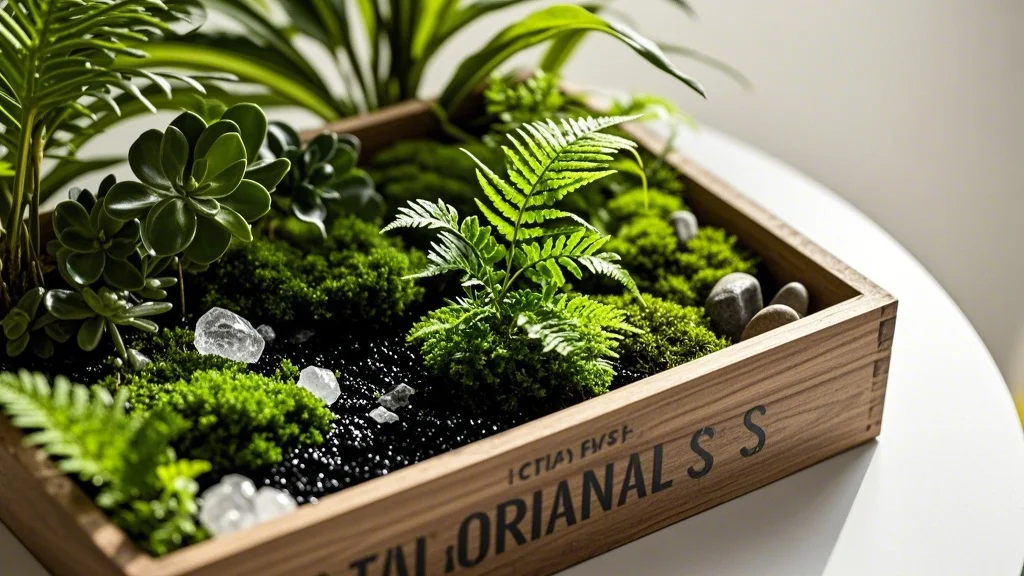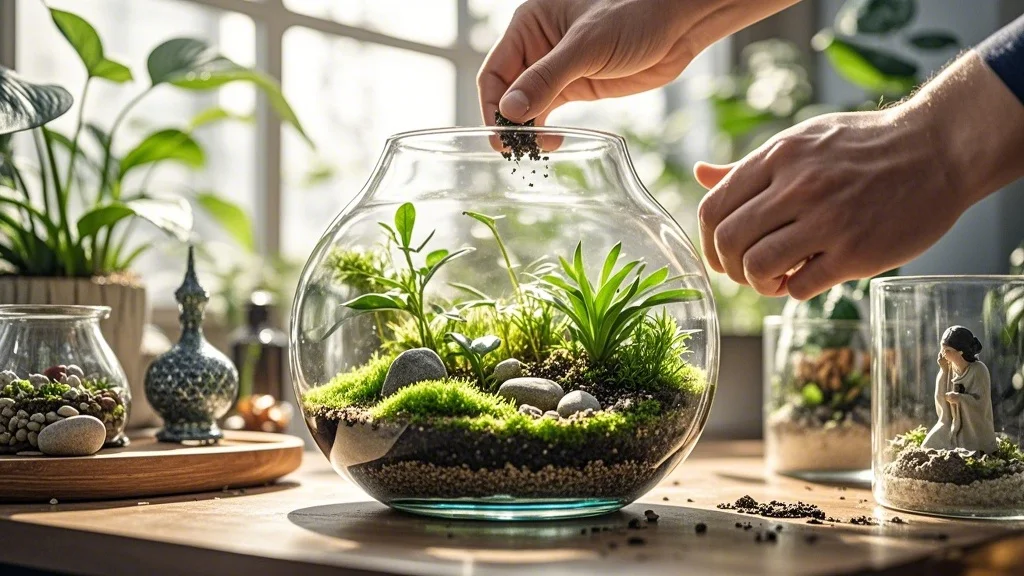In the bustling world of office life, a touch of nature can make all the difference. Enter the office terrarium: a miniature ecosystem that brings life and tranquility to your workspace. These self-contained gardens are not just aesthetically pleasing; they’re also incredibly low-maintenance, making them perfect for busy professionals. In this guide, we’ll explore how to create, maintain, and enjoy office terrariums that will thrive in your workplace environment.
Contents
- 1 What is a Terrarium?
- 2 Benefits of Office Terrariums
- 3 Choosing the Right Container
- 4 Selecting Plants for Your Office Terrarium
- 5 Essential Materials
- 6 Step-by-Step Guide to Creating Your Office Terrarium
- 7 Maintenance Tips for Office Terrariums
- 8 Troubleshooting Common Issues
- 9 Creative Ideas for Office Terrariums
- 10 The Impact of Office Terrariums on Workplace Well-being
- 11 Conclusion
What is a Terrarium?
A terrarium is a sealed or partially sealed transparent container housing a miniature ecosystem of plants. It creates a controlled environment where plants can grow with minimal intervention. For office settings, terrariums offer a unique blend of natural beauty and practicality, requiring little care while providing numerous benefits.
Benefits of Office Terrariums

- Improved Air Quality: Plants naturally filter air, removing toxins and producing oxygen.
- Stress Reduction: The presence of greenery has been shown to reduce stress and increase productivity.
- Low Maintenance: Once set up properly, terrariums require minimal care.
- Space Efficiency: Perfect for small desks or limited office spaces.
- Aesthetic Appeal: Adds a touch of nature and elegance to any workspace.
- Conversation Starter: A unique terrarium can spark interesting discussions with colleagues.
Choosing the Right Container
The first step in creating your office terrarium is selecting the appropriate container. Consider the following factors:
- Size: Choose a container that fits comfortably on your desk without obstructing your work area.
- Material: Glass is the most common choice, offering clarity and durability.
- Shape: Spherical, cubic, or geometric shapes can add visual interest.
- Opening: Decide between open or closed terrariums based on your plant choices and maintenance preferences.
Popular options include:
- Glass jars
- Fish bowls
- Geometric terrariums
- Repurposed light bulbs (for mini terrariums)
Selecting Plants for Your Office Terrarium
When choosing plants for your office terrarium, opt for species that thrive in low-light conditions and require minimal care. Some excellent choices include:
- Fittonia (Nerve Plant): Known for its striking leaf patterns.
- Peperomia: Comes in various species with different leaf shapes and colors.
- Moss: Adds a lush, green carpet effect.
- Air Plants (Tillandsia): Perfect for open terrariums.
- Pothos: A hardy vine that can be trimmed to fit smaller spaces.
- Ferns: Many small varieties work well in terrariums.
- Succulents: Ideal for open terrariums in brighter office spaces.
Essential Materials
Gather these materials before starting your terrarium project:
- Chosen container
- Small pebbles or gravel
- Activated charcoal
- Potting soil suitable for terrariums
- Selected plants
- Decorative elements (optional)
- Long tweezers or chopsticks
- Small watering can or spray bottle
Step-by-Step Guide to Creating Your Office Terrarium

1. Prepare the Container
Clean your chosen container thoroughly with soap and water. Dry it completely to prevent water spots.
2. Add Drainage Layer
Pour a 1-2 inch layer of small pebbles or gravel at the bottom of the container. This creates a drainage area to prevent water from pooling around plant roots.
3. Include Activated Charcoal
Sprinkle a thin layer of activated charcoal over the pebbles. This helps filter the water and keeps the terrarium fresh.
4. Add Potting Soil
Create a layer of potting soil above the charcoal. The depth should be sufficient to accommodate the roots of your chosen plants, typically 2-3 inches.
5. Plant Your Miniature Garden
Carefully remove plants from their pots and gently loosen the root balls. Create small holes in the soil and place the plants, ensuring they’re not overcrowded. Use long tweezers or chopsticks for precise placement.
6. Add Decorative Elements
If desired, add small decorative elements like pebbles, figurines, or miniature office supplies to create a themed landscape.
7. Water Lightly
Using a small watering can or spray bottle, lightly water the soil. Be careful not to overwater – the soil should be moist but not soggy.
8. Clean and Position
Wipe any soil from the container’s sides and position your terrarium in its designated spot on your desk.
Maintenance Tips for Office Terrariums
One of the greatest advantages of office terrariums is their low maintenance requirements. Follow these tips to keep your desktop ecosystem thriving:
Watering
- Closed Terrariums: These rarely need watering as they recycle moisture. If condensation disappears, add a small amount of water.
- Open Terrariums: Water sparingly when the top inch of soil feels dry. Avoid overwatering, which can lead to root rot.
Light
Place your terrarium in a spot with indirect light. Most office lighting is sufficient, but avoid direct sunlight, which can overheat the container.
Pruning
Occasionally trim plants to maintain their size and shape. This prevents overcrowding and keeps the terrarium looking neat.
Cleaning
Wipe the inside of the container with a soft cloth if condensation builds up excessively. This maintains visibility and prevents mold growth.
Fertilizing
Terrariums generally don’t require fertilizer, as the enclosed environment recycles nutrients. If plants show signs of nutrient deficiency after several months, use a very diluted liquid fertilizer sparingly.
Troubleshooting Common Issues
Mold Growth
If you notice white, fuzzy growth on the soil or plants:
- Increase air circulation by opening the terrarium (if closed).
- Remove visible mold with a small spoon.
- Sprinkle cinnamon (a natural anti-fungal) on affected areas.
Yellowing Leaves
This could indicate overwatering or poor drainage:
- Check that the drainage layer is functioning properly.
- Reduce watering frequency.
- If persistent, consider replacing affected plants.
Leggy or Stretched Plants
This suggests insufficient light:
- Move the terrarium to a brighter location (still avoiding direct sunlight).
- Consider adding a small LED grow light nearby.
Condensation Build-up
Excessive condensation can lead to plant rot:
- Open the terrarium to allow excess moisture to evaporate.
- Wipe down the container walls.
- Adjust watering practices to prevent recurrence.
Creative Ideas for Office Terrariums
Theme-Based Terrariums
Create a terrarium that reflects your profession or interests:
- Tech Theme: Include small circuit boards or computer parts among the plants.
- Literary Theme: Add miniature books or writing implements.
- Travel Theme: Incorporate small souvenirs from your travels.
Seasonal Variations
Change small decorative elements seasonally to keep your terrarium fresh and interesting:
- Spring: Add small butterfly or flower ornaments.
- Summer: Include miniature beach items.
- Fall: Incorporate tiny pumpkins or autumn-colored leaves.
- Winter: Add small pinecones or miniature snowmen.
Multi-Level Terrariums
For larger desk spaces, consider creating a multi-level terrarium using containers of different heights. This creates visual interest and allows for a wider variety of plants.
The Impact of Office Terrariums on Workplace Well-being
Incorporating terrariums into office spaces goes beyond mere decoration. Studies have shown that the presence of plants in the workplace can have significant positive effects:
- Increased Productivity: Research indicates that employees working in environments with natural elements like plants are 15% more productive.
- Enhanced Creativity: The presence of greenery has been linked to improved creative thinking and problem-solving skills.
- Reduced Stress: Interacting with plants, even visually, can lower stress levels and promote a sense of calm.
- Improved Air Quality: Terrariums, like all plants, help purify the air by absorbing pollutants and releasing oxygen.
- Boosted Morale: The act of caring for a terrarium, however minimal, can provide a sense of accomplishment and connection to nature.
Conclusion
Office terrariums offer a perfect blend of nature, art, and practicality for the modern workplace. By following this guide, you can create and maintain a beautiful, low-maintenance desktop ecosystem that not only enhances your workspace aesthetically but also contributes to a healthier, more productive work environment. Whether you’re a seasoned plant enthusiast or a beginner looking to add some green to your desk, a terrarium is an excellent choice for bringing a bit of life into your professional world. So why wait? Start planning your office terrarium today and transform your workspace into a miniature oasis of calm and creativity.







